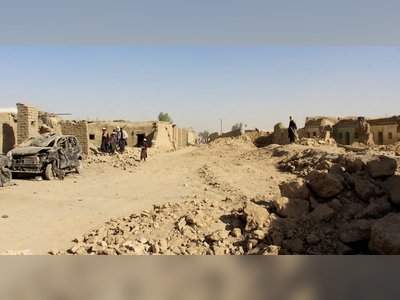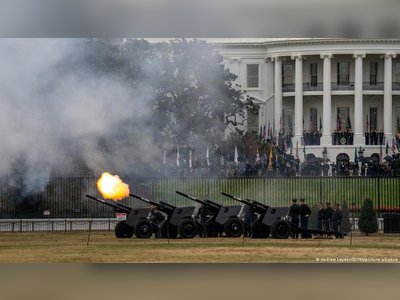
GV veteran shares Iraq experiences in new book
And the following year, Galvin found himself in Baghdad.
Now, he's published a book looking back on the experience and found some peace in the process of writing it.
Galvin, 64, joined the Army in 1975 as an enlisted infantryman, and soon after became a medic. In 1985, he completed Officer Candidate School in California.
And in 1996, he retired from the service as a 39-year-old captain.
But the idea of leaving the service behind changed on Sept. 11, 2001, when the terror attacks on New York City and Washington sparked a war in Afghanistan and later Iraq.
Second stint
In 2001, Galvin sent a letter to the Army volunteering to rejoin for the coming war. But he said they gave him a nicely worded "no thank you," and he left it at that.
However, things would change when the 2003 Iraq War began to take its toll in casualties and lackluster results, which led to a troop surge in 2007.
"The Secretary of Defense then wrote new policies on forces to support that strategy," Galvin said. "This was January-February 2007. And in that implementing guidance document, it specifically said we should engage retirees that have special skills. Whereas I had been turned down as a retiree after 9/11 in 2001. Suddenly, we became available."
Sandy, Galvin's wife, answered when the Army came calling in 2008 — four years after moving to Green Valley.
"She totally supported me," Galvin pointed out.
He attributed much of Sandy's understanding to her own time in the military. Sandy also retired after spending 20 years as a nurse in the National Guard.
Sandy said she didn't know what the Army wanted when she took a message, but the second time she answered, their call was a different story.
"I said, 'You'll need to talk to him, but I'm sure he'll be happy to do it,'" she said. "I said, 'Yeah, he's good. He wants to go.'"
At first, Galvin tried to get a posting in the continental U.S., but he ended up with Guantanamo Bay and the hopes of doing a bit of scuba diving and better U.S. Navy living quarters.
But when it comes to assignments in the Army, nothing’s guaranteed.
"I felt like, 'OK, the old bait and switch,' " Galvin said. "But it's like, 'I signed up. I said I would. You're changing the rules, but that's OK.' I did 20 years and had plenty of ‘on the one hand you're going to do this,’ and then plans change. You just kind of take it in strides."
And those strides landed Galvin in Baghdad in 2009 at Camp Victory.
Sandy followed the news during the war and was aware of how serious the situation was in Iraq.
Naturally, she was concerned but was reassured knowing he would spend his deployment in the Green Zone — the heavily fortified administrative headquarters in Baghdad.
"As far as his safety was concerned, it was OK with me," she said. "So, I didn't mind."
But the changes taking him to Baghdad instead of Guantanamo Bay didn't stop there.
Iraq assignment
At first, the Army assigned Galvin to a unit working on defeating cell phone-controlled improvised explosive devices attacking convoys.
"When I got there and reported to that particular team, they said, 'Well, we're not doing this as much as we were. So, we don't need you,'" he explained. "I said, 'OK, where to now?' "
From there, the Army sent Galvin to work with a unit doing key-leader engagement — speaking with local leaders the U.S. wanted on its side.
"The old 'hearts and minds,' " he said. "'You need to work with us, and this is what we can do for you. We can bring you military police, medical services, utilities and whatnot.' That lasted about 24 hours."
After that, Galvin headed to the Joint Operations Center, where he helped comb through Significant Activity reports — flagging those meeting specific criteria and sending them up the chain of command.
"If it meets that criteria, or exceeds it, we made a PowerPoint presentation about it," he said. "We had 12-hour shifts, seven days a week. But hey, I could scoot out for breakfast, lunch and dinner. And a cigar on the balcony once in a while."
However, it wasn't just 12-hour shifts every day of sifting through paperwork that took its toll on Galvin — it was the detailed and graphic nature of those reports.
"As you can imagine, some of them were pretty difficult," he said. "Because any time there was an ambush of a convoy, they had to report it. And vehicles damaged, people killed — the PowerPoints were pretty thorough."
Looking back
On Sept. 23, Galvin spoke to 22 members of the Green Valley chapter of the Military Officers Association of America at Longhorn Grill and Saloon in Amado.
There, Galvin talked about his book, "PowerPoint Ranger, My Iraq War Logs."
However, an older-model projector nixed the PowerPoint presentation that accompanied the talk.
As the MOAA members listened to Galvin's presentation, he reflected on an incident still fresh in his mind.
Dealing with graphic SIGACTs depicting wounded or killed U.S. service members and civilians could be troubling enough, but Galvin found learning even more about those in the reports made it even worse.
"It was around April, it's in the book, there was a convoy that had been ambushed as it was coming outside of a forward operating base," he told the audience. "A dump truck full of explosives basically ran into the first vehicle of the convoy and into the wall of the FOB and blew up. And it took out that truck and five guys."
Galvin and a fellow captain became intimately involved in how the five soldiers died. But it wasn't until they learned more about how they lived after the chaplain's presentation that the trauma of the situation set in.
It came during a Fallen Heros Salute for the five soldiers a week after the dump truck killed them.
"He started telling us how these guys lived and what their aspirations were," Galvin said. "There was the high school football coach, and the teacher’s comments up close. We had to stand there.
We knew how these guys died, and now we knew about them personally. And it was tough. I got to tell you, the other captain and me, boy, the tears were going. That was tough. That's the kind of stuff that went on in that Joint Operations Center."
While writing the book helped Galvin come to terms with his time in Iraq, it wasn't something he jumped into right away.
"I thought about it for a while, but, 'Naw, let old dogs lie,' " he said after the MOAA members left. "I didn't want to potentially scrap off some of those scabs, like the five guys who died around Easter."
But while Sandy was recovering from medical treatment, Galvin thought about finding something to do while spending time at home with his wife.
While at the woodshop, Galvin asked his friend and Navy veteran Roger Lynch how he wrote his books.
What Galvin came up with was a book about his experiences told through fictional characters.
Galvin's Army Capt. Matthew Jerome — his real-life father's first and middle name — depicts his experience during the war.
And Sandy said she could see the difference since Galvin completed the book, which helped him come to terms with the experience.
"It has been a great help," she said. "I was hoping he would (write it) to get it out of his system, but I wasn't sure if he was ready to do that."
However, Galvin found the whole process therapeutic for both him and Sandy.
"We'd sit down, and I would read things to her, or let her go through it, and she would recall certain things that helped me correct it," he said. "So, it was really a collaborative effort with her helping me edit and go through it. It was actually good for both of us."











